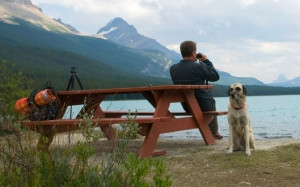Sunny summer temperatures lure us outdoors, and our dog’s or cat’s companionship makes those long, light-filled afternoons even brighter. However, we caretakers must protect our pets from warm-weather hazards! Whether you’re planning outdoor activities for dogs, make a cross-country road trip, or garden in your backyard, a few minutes of planning can keep you and your pet healthy and safe.
PROTECT YOUR PET FROM HEAT
Waiting in cars and lying on hot concrete or asphalt are the most common causes of heatstroke in pets. Even in the shade with the window cracked open, a car’s interior can reach 160°F in minutes, causing heatstroke, brain damage, and death. If your dog or cat can’t come with you when you get out of the car, leave him at home or board him for the day. Whenever your pet is outdoors, whether by himself or with you, make sure there is always a cool, shady surface where it can escape the heat.
Because cats and dogs do not sweat except for a small amount through their footpads, provide constant access to cool, clean drinking water. Heatstroke injures or kills pets who cannot keep their bodies cool enough by panting. In addition, when the air temperature is close to body temperature, panting doesn’t work well. That’s why water, shade, and a cool surface to lie on are essential during summer days.
PACK PROPERLY FOR OUTDOOR ADVENTURES
Check that you have the 6-foot leash that’s required in most metro and suburban areas and parks, and attach a pocket to dispense bags for pet waste disposal. If you plan to walk more than a few blocks, take water for yourself and for your dog. Supply your own dog’s water because, in any area where pets drink from common water supplies, diseases spread. These settings are also excellent for picking up fleas and ticks that ride in on other people’s pets—so protect your pooch with anAdamsTM Spot On® treatment.
For hikes away from conveniences, additional items to pack include a snack for your dog, latrine trowel, a fold-up water dish, and a first-aid kit. Treat your pet with a pest spray like the Adams™ Flea & Tick Spray to kill fleas, flea eggs, flea larvae and ticks when visiting woodsy or damp areas. In case you and your dog become separated, be sure that his name and your cell phone number are listed on his pet identification tag. Consider microchipping your faithful companion as well because collars can break or slip off.
After your outdoor adventure—whether short or long, urban or country—inspect the pads on your dog’s feet, as well as his nails and dewclaws, to ensure that they are in good condition. Groom between his toes to remove any mats or stickers.
PLAN LONG-DISTANCE TRAVEL IN ADVANCE
Discuss your travel plans with your veterinarian. Recent weather patterns have changed the historical distribution of parasites, such as heartworm (carried by mosquitoes), and diseases such as Lyme disease and Rocky Mountain spotted fever (carried by ticks). In addition to flea and tick prevention, your veterinarian might recommend either vaccines or a monthly heartworm preventive medicine.
As part of your preparation, make room in your car for a crate—your dog’s “home away from home.” Not only will a crate give him a sense of security while traveling, but crated dogs do not suffer the injuries of unrestrained dogs (and unrestrained dogs may cause preventable distracted-driving accidents).
Pet-friendly hotels and campgrounds are becoming more common. Out of respect for your fellow travelers—and to protect yourself and your pet from less careful travelers—use a flea and tick preventive such as an Adams™ Spot On® treatment. Also, consider carrying a spray or mist likeAdamsTM Flea & Tick Spray with you that can help if you encounter fleas or ticks. Not only is summer prime mosquito season, but cat and dog flea populations rise through the spring and summer months. As people and animals move rapidly through vacation and recreation areas, fleas, ticks, and the diseases they host can spread just as quickly.
PREPARE THE BACKYARD
If you plan to spend your time in your own backyard, consider this: Underbrush, tall grass, and woodpiles provide hiding places for wild animals that carry ticks and fleas into your yard. Long after the animals are gone, their fleas and ticks persist. During peak pest-breeding season, trim underbrush and grass, and consider removing your woodpiles. If ticks and fleas become a persistent problem in your backyard, or if you need mosquito control products, Adams™ yard spray may help you protect your pets.